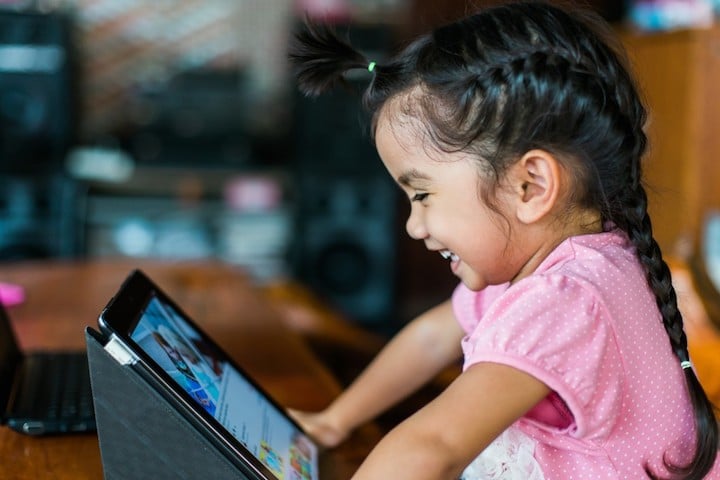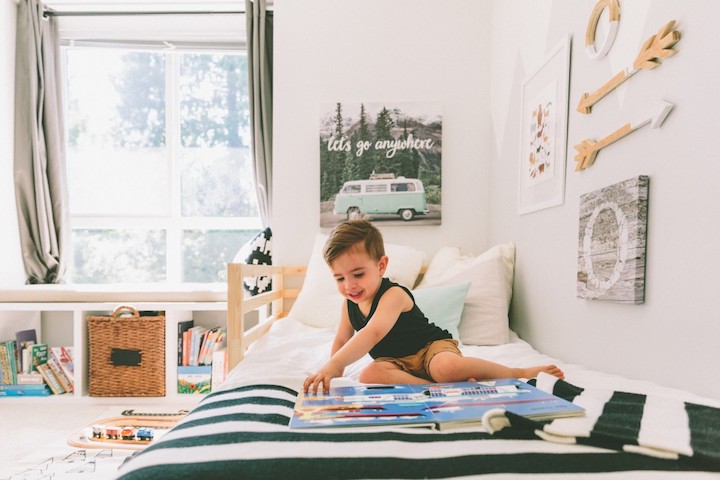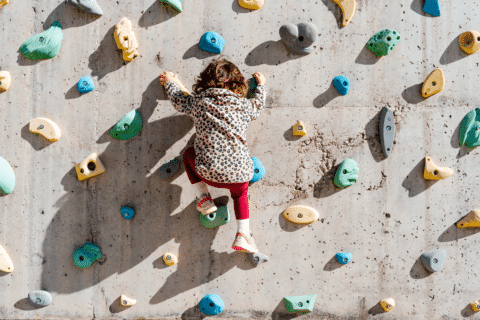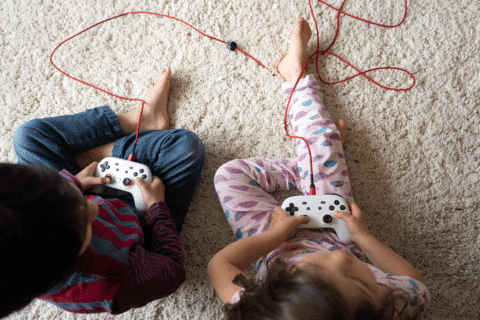Before I had a child, my social media feed was full of cocktails, landmarks, and artsy photos of the sky. But after Lucy was born, it was all baby, all the time — so much so that I even opened a second Instagram account so I could chronicle every expression, smile … and spit-up incident.
It was cute. It was fun. But as Lucy became a toddler and began to demand to see the photos I took, I began thinking: What will she think of the feed when she is big enough to find it herself? Would she feel embarrassed by a photo of her with a bright red mid-tantrum face? Will she feel exposed by a photo of her running into a sprinkler without a shirt?
Social media rules for babies
I never wanted Lucy to feel anything negative about a feed that was begun as an expression of love and delight. That’s why I wanted to do a gut check on social media rules for posting photos of kids.
What I found? It’s a brave new world for all of us. I spoke with a psychologist and an educator. Here are their approaches to your kids’ photos and social media exposure.
Needless to say, thinking about some of my child’s own potential concerns led me to hit the “trash” icon a few times. I also felt more confident about the photos I did choose to upload.
The psychologist’s take: start talking about social media early
Juli Fraga, PsyD, is a psychotherapist who specializes in postpartum depression and relationships.
“Posting photos of our kids’ birthday parties, summer vacation antics, and sports events are one way to record memories and share the treasured moments with loved ones. However, images on social media remain online forever. Because of this, as kids get older, they may feel uneasy when parents share their photos.
If your child feels uncomfortable, hear him out. Gather more information by asking, “What about the photo makes you feel embarrassed/anxious/uneasy?” Kid fears differ from adult worries so even if their concerns seem mild (“I don’t like the outfit I was wearing.”), steer clear of minimizing their feelings. Instead, validate their emotions by saying something like: “I can see why you feel uneasy,” or “Thank you for telling me that you’re uncomfortable.” Tough conversations are part of family life, and your child will benefit from feeling heard.
Kids, especially tweens/teens like to be included in the decision-making process. With that in mind, allow them to veto the photos they dislike. Giving them this option can help them feel empowered.
In an era when people spend almost two hours each day on social media, communicating about online use is vital for every family. You may even create social media rules for everyone to abide by. This might include asking each other for consent before posting a picture online, as well as discussing who will see the image that’s shared.
A social media tutorial in privacy settings can also be beneficial. Sit down with your kids, open up Facebook and show them who can view the photos on your wall. These family activities can also be a useful way to teach your child how to use social media responsibly.”
The teacher’s take: think about how you would feel
Fiona Tapp is an educator and writer with a Master’s Degree in education.
“When I first became a parent, I excitedly shared so many photographs of my new baby on social media. My feed was overrun with multiple posts per day featuring his teeny little hands, all his cute outfits, and every little developmental milestone recorded for prosperity.
Then I started to hear about some friends who had decided not to put photos of their child on the Internet at all, citing privacy concerns, and it made me reconsider how I was recording and sharing my son’s life.
As a teacher, I would often see the parents of my students publicly posting treasured moments from their vacations, or celebrating their child’s success at a dance recital or swim meet.
But I also saw things that I didn’t think were appropriate.
Like the time, a mom shared a pic of a haircut gone wrong where her son looked visibly distressed or a dad who crowdsourced for an appropriate punishment when his daughter broke her curfew.
Problems seep in not when parents simply share but when they overshare. I think it’s important to always remember that our children are people too and are entitled to privacy. Sure, go ahead and share a picture of your recent vacation but if you wouldn’t want a similar picture of yourself out in the public space then don’t post one of your child. That means no potty training shots, no videos of kids in distress or having a tantrum, and no sharing information about your personal family situation, like marital troubles, custody arrangements, or punishments.
As your child grows and becomes more independent it’s likely that she will begin to post things herself that you might think are inappropriate or unwise. If you have exercised caution in the things you decide to post you’ll be setting a good example for them to follow by staying safe in digital spaces.
Remember that images on the internet can live forever. If you wouldn’t want a college admissions committee or future employer to see the picture of your child then don’t share it now.”
The parent’s take: So, what do you do?
Ground rules are great. But on the Internet, when it sometimes feel you’re shamed for sharing (why did you post that?) and shamed for not sharing (we never see your baby!) it can be tough to find the middle ground.
I know when I hear of parents who decide to keep their child’s name, identity, and photos entirely off the Internet, it makes me wonder if any photo of my child was TMI. But what I’m realizing — and what experts agree with — is that decisions on social media sharing are personal ones to be made with your partner and family.
A few universal ground rules can help put everyone in your family on the same page, mitigate misunderstandings between friends and family, and pave the way for sharing with confidence.
Set your own rules
Having your own stated rules and expectations can give you confidence in what you share. (It won’t be long before you’re setting rules for your child’s cell phone use, so this is a great time to start laying the foundation.) For example, I share photos of my daughter on a locked Instagram feed, but I don’t share photos of her on my public Twitter feed. I try to make to post photos I would be happy about if someone were to share the same of me (yes to a smiling face, no to lying on the ground kicking and screaming). I occasionally go back and delete a photo if I have second thoughts.
Consider locking your profiles
Some people lock their social media accounts so they can vet their followers. Other people use invite-only apps, like TinyBeans, to share moments with friends and family. If you have loved ones sharing photos of your child as well, it’s also a good idea to talk about privacy settings and what your preferences are.
Set expectations among family members and friends
Maybe you want to give an okay before your parents post a pic of their grandchild. Maybe you would prefer that they only share on a private Facebook page, rather than a public Twitter feed. It’s completely reasonable to ask others not to share photos of your child, or not to make them public. Or maybe you don’t care what photos they share, but want them to leave your child’s name, school, or other identifying details out. Whatever your expectations, let people close to you know your thoughts.
Ask permission before you post a photo of another child
If you have a picture of your toddler and her best friend, ask his parents before you post, and respect their wishes if they say no. Remember: it’s not personal, and it doesn’t mean they’re pulling the superior card. They just have different social media plans than you have.
I have one friend, Jen, who didn’t want to share social media photos of her daughter. Another parent posted a group photo of toddlers at a mommy-and-me class — including Jen’s daughter. Jen asked for it to be taken down, and the other mom took offense, even going so far as to say that if Jen wasn’t comfortable with photos, maybe the class wasn’t the right place for her and her child. Jen was mortified, but she was also glad she stood her ground. She says that this was the only time, so far anyway, that she has ever received pushback.
“I think it’s important to not be accusatory,” says Jen. “Now, I say something like, ‘That photo of the girls is so cute, and I’d love if you could send it to me. We aren’t big social media people, and for right now, aren’t using social media to share pictures. Can you take down that photo?’” Jen adds that if people push, she cites her husband’s sensitive employer. “What I’ve learned is that people don’t want to feel like they’re doing something wrong because they’re sharing photos. And I don’t think they are. It’s just not what we do, and I feel it’s sometimes easier to say it’s because of a job thing rather than a philosophy.”
Consider a pseudonym or initial
If you regularly share with followers, especially if they’re strangers, it can be smart to take a cue from bloggers and Instagrammers and assign your kid a nickname, initial, or pseudonym. That way, the feed or post may not be as readily findable when your child is applying to colleges or a job and gives your child the freedom to build his or her own Internet identity.
You can always change course
While it’s true that the Internet never forgets, social media is designed to be ephemeral, and deleting or trashing a post is always an option. As your children get older, you can also ask their thoughts as well, and come up with a strategy that everyone can “like.”
Anna Davies is an editor at Haven Life. She has written for The New York Times, New York Magazine, Refinery29, Glamour, Elle, and others, and has published 13 young adult novels. She lives in Jersey City, NJ, with her family and loves traveling, running, and trying to find the best cold brew coffee in town.





